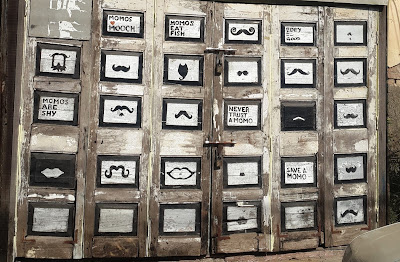- by Deepa Krishnan
Whenever I go to the markets, I wonder about the women who sit there, running small businesses. What sort of life do they have? How do they survive in the city? Recently I came across this coriander-and-lemon seller.
She was wearing her traditional green bangles and mangalsutra, but she had switched from cotton to synthetic sarees. She probably finds synthetics easier to wash and maintain, especially in the monsoons. And there is less wear-and-tear on the sarees, making it more economically viable.
I tried to imagine what her day was like. She has probably woken up at 4 am, and gone to the big market at Dadar or Vashi or Byculla, to buy at wholesale rates. It is likely that she had no time or inclination to make tea at home. Perhaps the rest of the family was fast asleep at that time. It is likely that she travelled by train, with an empty basket on her head. At the wholesale market, she must have walked around, trying to find a good rate. After buying her stock, she probably stopped to have some sweet milky hot tea.
Then, she must have made the journey by taxi and train, to her little roadside spot in the local market. I tried to estimate what she spends on her commute. Probably around 30 to 50 rupees each day, getting to work and back.
The total stock in her basket is probably worth somewhere between Rs 800 to 1000. If she sells it all, then she will probably make somewhere between Rs 200 to 300 per day. She probably needs to spend around 30 rupees on food, because she leaves home too
early to cook and carry a meal. Perhaps she also needs to spend around
5-10 rupees on using a public toilet. After expenses, finally her profit for the day is unlikely to be more than Rs 100.
She is unlikely to work every day of the month; due to illness, or family constraints, or festive occassions, or village visits. So my estimate is that she earns not more than Rs 2500 per month. Of all the vegetable vendors in the market, the lemon-seller is probably among the lowest earners.
The markets of Mumbai are full of women, with small stalls of their own. Here's a kad-dhanya shop, I think her stock is worth around Rs 5000 (she had lots of stuff under the table as well). She is wearing her traditional khuna blouse, and green bangles, and the tattoos, but her saree is also synthetic. My estimate is that her income is around Rs 4000 per month.
This photo below is actually a temporary shop, which came up in Bhuleshwar around a festival. It's only a day's affair, and she will make probably Rs 500 on this day if she sells all her stock (quite likely). She is also wearing a synthetic saree, as you can see. It is quite clear to me, that cottons are dying out.
Most of the women I see selling vegetables are 40 years or older. I rarely see young women. Perhaps fewer younger women are entering this
sort of business? I will keep my eyes open for younger women, next time I
go to the market. And I will ask some of the older women whether their daughters or daughters-in-law are going to follow in their footsteps.










































